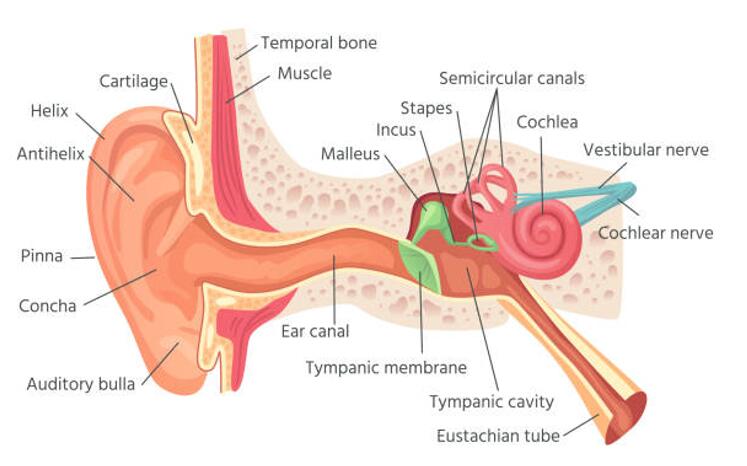The ear is an important organ in the human sensory system. It can convert sound waves into signals that the brain can interpret. In addition, the fluid in the ears also helps the body to coordinate and maintain a sense of balance. The ear is composed of three parts, divided into the outer ear, middle ear, and inner ear. Each part has its own special function.
If any part of the system is damaged, it may cause difficulty in hearing and even hearing loss. This article discusses parts and components of the ear and their functions. Understanding the structure of the ear and the function of each part can help you keep your ears healthy and safe.

The Outer Ear
The outer ear, also known as the auricle or pinna, is the visible part of the ear that protrudes from the side of the head. It consists of the following components:
1. Auricle
The auricle, the external portion of the ear, comprises cartilage covered by skin. Its unique shape helps collect sound waves and direct them into the ear canal.
2. External Auditory Canal
The external auditory canal, commonly called the ear canal, is a tube-like structure connecting the auricle to the middle ear. It is lined with specialized skin and helps transmit sound waves to the eardrum.
3. Tympanic Membrane
The tympanic membrane, commonly known as the eardrum, is a thin, cone-shaped membrane at the ear canal’s end. It vibrates in response to sound waves, converting them into mechanical energy.
The Middle Ear
Situated between the outer and inner ear, the middle ear contains vital components that contribute to the hearing process. Let’s explore these structures:
1. Ossicles
The ossicles are a chain of three tiny bones within the middle ear: the malleus (hammer), incus (anvil), and stapes (stirrup). They are crucial in transmitting sound vibrations from the eardrum to the inner ear.
2. Eustachian Tube
The Eustachian tube connects the middle ear to the back of the throat. It plays a significant role in equalizing the pressure between the middle ear and the atmosphere, ensuring the proper functioning of the eardrum.
3. Oval Window
The oval window is a thin, membrane-covered opening that separates the middle ear from the inner ear. It acts as a gateway for sound waves to enter the fluid-filled chambers of the inner ear.
The Inner Ear
The inner ear is a complex structure that converts sound vibrations into electrical signals that the brain can interpret. Let’s delve into its remarkable components:
1. Cochlea
The cochlea is a snail-shaped, fluid-filled structure in the inner ear. It contains thousands of microscopic hair cells that convert sound vibrations into electrical impulses, which are then transmitted to the brain through the auditory nerve.
2. Vestibular System
The vestibular system, also located in the inner ear, is responsible for our sense of balance and spatial orientation. It consists of three semicircular canals and the vestibule, filled with fluid and lined with specialized hair cells.
3. Auditory Nerve
The auditory nerve carries electrical signals from the cochlea to the brain, where they are processed and interpreted as sound. This crucial pathway allows us to perceive and make sense of the sounds around us.
FAQs
1. What is the role of the pinna in the ear?
The pinna helps in collecting and funneling sound waves into the ear canal. Its unique shape and structure aid in sound localization and improve our ability to perceive the directionality of sound sources.
2. How does the eardrum work?
The eardrum, or tympanic membrane, vibrates in response to sound waves. These vibrations are then transmitted to the ossicles, which amplify and transmit the sound to the inner ear.
3. How does the vestibular system contribute to balance?
The vestibular system detects the head position and movement changes, helping us maintain balance and spatial orientation. It informs the brain about our body’s position in relation to gravity and enables us to adjust our movements accordingly.
4. Can hearing loss be caused by problems in the middle ear?
Yes, hearing loss can occur due to issues in the middle ear. Conditions such as fluid buildup, ear infections, or ossicle damage can interfere with transmitting sound vibrations to the inner ear, impairing hearing.
5. What happens to sound signals after they reach the auditory nerve?
Once the sound signals reach the auditory nerve, they are carried to the brain’s auditory processing centers. The brain then interprets these signals as specific sounds, allowing us to perceive and understand auditory information.






